Review for Tiger & Bunny Part 1 Blu-ray & DVD Combo Pack
Introduction
It’s odd how we perceive different cultures. Both the US and Japan have big comic book heritages that feed through popular culture and mass media. In the US, comic books and graphic novels spin off cartoons, videogames, novels, TV series and movies. In Japan, manga comics do the same, unleashing anime, videogames, all the way up to movies. Yet in the US this comic book chain of creativity almost exclusively focuses on the phenomenon of the superhero, a protagonist with fantastic abilities who serves as some sort of protector or crime fighter. In Japan, manga comics are anything but. There are characters with amazing abilities and powers, but they are ninja, or samurai, or vampires, and stories vary from sci-fi action to romance, to supernatural and anything else you can come up with. No one wears their underpants over their tights in manga comics, and the only characters wearing capes are giant robots. Of course this all a gross generalisation, and reality is as usual more complex. But generally, manga and anime has left the superhero genre alone, letting the Americans get on with it, with the rare exception of Marvel hiring Studio Madhouse to make Ironman and Wolverine anime.
We’re in one of those navel-gazing introspective periods in anime, the recession causing most studios to look to their domestic markets first and foremost. The mid-2000s boom when foreign studios were throwing money at Japan to license and co-produce anime are long gone. But even in this period, there are those trying to create a break out hit that will be big across the world. Sunrise have decided to take on the Americans at their own game, and make a show about superheroes. We’re talking proper Marvel territory here, with a lot that will be familiar to fans of the traditional superhero comic, and a minimum of Japanese cultural references to confuddle the average newcomer to anime. But simply repeating what has already been done in the US would be pointless and self-defeating. Sunrise needed to create something new and original. The seeds in popular culture are already present to move the superhero genre to a new level. We’re talking reality TV and corporate sponsorship. The latter has already been touched upon with Mystery Men, but in Tiger & Bunny, the superheroes are contestants in a TV show, competing to see who the best of them all is. Kazé Entertainment now release Tiger & Bunny in the UK, distributed by Manga Entertainment.
The future has arrived, and with it the superheroes. Some forty years previously, genetic mutations started appearing in people, resulting in them developing strange powers. They were called NEXT, and some of them began using their powers to help people. They became the heroes that stopped crime and kept people safe. Today, in Stern Bild city, heroes are big business and indeed entertainment. Sponsored by major companies, they compete in a game show called Hero TV, trying to rack up as many points as possible as they go about their hero business to be crowned King of the Heroes each year. Of course being telegenic, and knowing just how to make an entrance are important as well.
Not so important to Wild Tiger, a.k.a. Kotetsu Kaburagi who got into the hero business for the old fashioned reason, to help people. He uses his ‘Hundred Power’, an ability that boosts his strengths 100-fold, but only for five minutes, to try and do good, but his enthusiasm usually leaves a lot of property damage in his wake. As a result he tends to slip down the rankings. It gets to the point where his sponsors pull out, and his manager quits. He’s got just one chance to redeem himself, and join a new corporation that is trying something new in the hero game. They’re establishing a hero team, a first for Hero TV, and Kotetsu will be sidekick to the hottest young thing on the block. Barnaby Brooks Jr. has the same powers as Wild Tiger, but that’s where the similarity ends. His approach to the superhero business is diametrically opposed to Kotetsu’s and he’s a lot more business-like and pragmatic in his attitudes. He’s also got a very personal and not at all altruistic reason for becoming a hero. Naturally they wind up butting heads on the first day on the job. They may not be much of a team, but at least the new suits look cool, and as long as Hero TV’s ratings go up, Wild Tiger may just hold onto his job.
The first seven episodes of Tiger & Bunny are presented in this combo collection from Manga Entertainment via Kazé. For your money, you get one Blu-ray disc, two DVD discs (splitting the episodes four-three), and some interesting physical extras in the box. For the purposes of this review, I watched the Blu-ray in Japanese, and the DVD in English.
01. All’s well that ends well
02. A good beginning makes a good ending
03. Many a true word is spoken in jest
04. Fear is often greater than the danger
05. Go for broke!
06. Fire is a good servant but a bad master
07. The wolf knows what the ill beast thinks
The Blu-ray
Seven episodes are presented on this Blu-ray disc, at 1.78:1 aspect ratio at 1080p resolution, with the choice between PCM 2.0 Stereo Japanese accompanied by player forced subtitles and signs and PCM 2.0 stereo English with player forced text translations, but only on those episodes that require it. You can change the audio options from within an episode using the pop-up menu. The image is clear and sharp throughout, and is indicative of an HD show animated at lower than full HD resolution, and up-scaled to 1080p, as is the situation with most modern television anime. Colours are strong, the animation comes across with vibrancy at the intended frame rate, and detail levels are high, especially in the cityscape backgrounds. The audio also comes across with no issue, although once again we have an action-oriented show which really ought to have a surround audio track, but doesn’t. I noticed just one scene that suffered from digital banding, in a fade to black where such is most likely to become apparent.
The DVDs
Here you get two discs, with four episodes on one, and three episodes plus extras on the other. The image comes in PAL 1.78:1 anamorphic widescreen format, with the requisite 4% speed up due to differing frame rates. The image is clear and sharp throughout, and it’s a strong presentation from Kazé, with bold colours, well defined lines, and smooth animation that is visually free of compression signs. It’s as good as an SD anime disc can be assumed to look. The audio comes in DD 2.0 Surround English and Japanese, with player forced subtitles and signs. It’s here that the presentation takes a bit of a knock, as I heard some distinct clipping in the background music as associated with pitch correction. It’s enough to make the Blu-ray the preferred option, before even considering the higher resolution.
Picture
At first acquaintance, Tiger & Bunny is a very appealing visual experience. They’ve got the character designs just right, memorable and evocative of the genre. Should Sunrise wish to develop this world further, I could see this as an upstart challenger to the worlds of DC and Marvel, such are the varieties of superhero and supervillain in this show, so well portrayed are their abilities. Also Stern Bild is a suitably impressive Metropolis for this series, large scale and futuristic. The colours are impressive, the action sequences are brilliantly animated, and the way that corporate sponsorship is incorporated into the show is very well done. It’s when things quieten down that the seams begin to show. For the less animated, talky sequences, it’s as if the budget suddenly runs out, and the animation becomes more static, and worse the characters begin to drift off model, especially in mid-range to distance shots. They can’t even keep Kotetsu’s goatee consistent between cuts. It’s disheartening to see on DVD, and it’s even more disappointing on a large screen in the otherwise impeccable Blu-ray.
The images in this review are sourced from the PR materials, and aren’t necessarily representative of the final retail release.
Sound
While 5.1 audio would have been nice, the stereo does a great job in conveying the show’s action sequences, and makes the most of the music soundtrack which calls to mind classic superhero cartoons and TV shows. The dialogue is clear in both versions, and for the first time in quite a while, I gave equal attention to both English and Japanese audio, watching the show twice. Personally I prefer the Japanese audio, as for me Hiroaki Hirata, the Japanese voice actor behind Kotetsu puts a lot more dimension and nuance to the role. He delivers many different shades of sarcasm. In comparison Wally Wingert plays the role a lot more broadly. I’m also not too convinced by Barnaby’s pronunciation of Ouroboros in the English dub, as it fails to be consistent from one utterance to the next.
That said, for me Tiger and Bunny gets the best English dub an anime has seen in many a year. It’s as if they got the lee-way to do a proper adaptation for the US market, rather than sticking closely to Japanese expectations, which can scupper a dub. As a result the adaptation is looser, flows more easily and references 60 plus years of US comic book superhero heritage. Watch the dub version and you forget that you’re watching an anime, and it comes across as a US superhero cartoon.
After months of complaining about Kazé’s subtitling, they almost get it right with Tiger and Bunny, although they’re helped as with Code Geass by the show taking place in a world where the text and advertising is in English. In fact in this show where there is plot specific text on screen, this will be translated and hard-subbed into Japanese text. At moments like this, the Kazé discs will translate that translation, so you get an English subtitle caption that repeats what is said in the text on screen. This is for the Japanese audio track, not the English. The signs track is really for the sake of Saito, Tiger and Barnaby’s suit engineer, where the running gag is that his voice is practically inaudible. Hard subbed Japanese text appears on screen at these moments, which is translated into subtitles for both the English and Japanese audio. While the songs in the show are also dubbed into English, for the Japanese audio track the inconsequential ones aren’t subbed, while Blue Rose’s number in episode 4 is. Where Kazé fail this time is that they haven’t provided subtitles for either the opening or closing theme songs.
Extras
Both the Blu-ray and DVDs present their content with animated menus. As always with Kazé, they are locked away from the user. If you are a hard of hearing English dub fan, who needs subtitles to back up the audio, you’re out of luck here, but given that the English dub translation is looser than usual for anime, it wouldn’t really help. There is an error in labelling here as well. The Blu-ray disc promises extras, but in actuality the only extra features are on the DVD disc 2.
Here you’ll find the textless credits, albeit with burnt in karaoke subtitles.
There’s also the 24-minute making of featurette, which is presented in NTSC-PAL format. It begins much like a corporate presentation, as the creators try and define a target audience for this show. It then takes us behind the scenes at Sunrise Studio 6 where we can see the animators at work, and it also provides interviews with the voice cast and the crew. There’s also a big chunk of episode 1 as a sneak peek, revealing this to be a preview documentary for Japanese TV, rather than a companion piece completed for these discs. While the dialogue is all subtitled, few of the captions are, so good luck figuring out just who is speaking.
I didn’t get them with the review discs, but this release also comes with 3 Hero Comics (translated from the Japanese) and 3 collectible cards.
There’s been some discussion about the corporate logos in this anime and how the show is sold around the world, especially after a report about the Taiwanese Region 3 DVD release seemed to indicate that the logos had been removed. They are still present in the episodes in the UK release, and do appear on the cover of the case. However, having seen Manga’s unboxing video, it transpires that they aren’t on the interior art, and neither are they inside the hero comics (they are on the cover though) or on the cards.
Conclusion
Tiger & Bunny really is a show that needs to be on TV. Not because it’s that good, but because it is the most audience friendly, accessible anime show that has come from Japan in years. This isn’t a show that requires a background familiarity with Japanese culture. It’s so light in on screen Japanese text that it has to be hard-subbed for Japanese audiences, and its subject matter is so familiar to Western comic-book fandom that it has a pre-existing audience. It should be on prime time television, and indeed it has had an airing in the US. Of course in the UK we come up against the cartoons for kids prejudice, which, with Tiger & Bunny’s darker edges, more adult storylines, just won’t countenance anything other than a teen audience, an audience which is just no longer catered for with UK television. So it remains, locked behind a paywall at Anime on Demand, where for the past two seasons it just hasn’t been accessible. In all likelihood, Tiger & Bunny will achieve the same success here in the UK as most other anime, failing to break out of its niche.
That would be a shame, as for once an anime gets a dub which is universally accessible, and caters for the local audiences. It really is a great premise, a future world where superheroes and supervillains exist, and where said heroes are supported financially through sponsorship, taking part in a reality TV show to see just who is the most popular and successful of them all. It takes a well-established comic-book genre and freshens it up with a modern pop-culture twist. At the heart of its narrative is a really great odd couple relationship, the veteran, freewheeling Kotetsu, and the rookie, by the book Barnaby, the Tiger & Bunny of the title. Their initially antagonistic relationship slowly begins to transform over the course of these episodes, as they bug and annoy each other through their missions. Barnaby insists on calling Kotetsu ‘Old Man’, while Kotetsu quickly dubs Barnaby Bunny on account of his long eared hero suit. Neither appreciates this, and watching the two somehow working together despite annoying the hell out of each other is a large part of this show’s fun.
But in one, fundamental way, Tiger & Bunny is really quite a conventional anime. Its story structure, and the way it develops is pretty standard, the way it sets up its world, introduces the characters, begins to develop them, and then starts feeding in bits of back-story, before getting to the main storyline. We’re just getting started in this first collection of episodes, and with only a quarter of the show here, it’s understandable that it doesn’t quite satisfy just yet.
The first episode sets up the status quo, introduces the heroes through the medium of Hero TV, as they work against each other to nab some villains and score some points. It’s immediately enough to give you an idea of how the show works, and introduces Wild Tiger as a hero of the old school, who isn’t quite comfortable with the popularity contest that is Hero TV, and still believes that his first duty is to help people. It also reveals that his enthusiasm tends to result in a lot of collateral damage, and few arrests. We also meet the other heroes, the flamboyant Fire Emblem, the somewhat dopey Sky High (who somehow stays atop the hero rankings despite his daft catchphrase), the glamorous pop idol Blue Rose, the brawny Rock Bison, the kung-fu wielding Dragon Kid, and the shy and retiring Origami Cyclone. In their midst appears a new hero, one who breaks the usual hero rules. For one, he goes by his given name of Barnaby Brooks Jr. and for another, he’s happy to show his face to the masses, rather than hide behind a mask. The episode ends with that status quo upset, and with Wild Tiger now sidekick to the annoying rookie.
From that point on, their partnership is developed over the next few episodes, usually to comic effect, and we also get some insight into Kotetsu’s past, how he was inspired by an early hero named Mr Legend, and how he’s driven to impart that same hope to other young NEXTs coming to terms with their powers. We also meet his daughter, and they have a typical teenage daughter absentee father relationship. Tiger & Bunny does a fair job in revealing the human side to these superheroes, not only in Kotetsu’s relationship with his daughter, but also how the other heroes live out of uniform. Episode 3 gives us some more Hero TV antics, as the camera crew follow Tiger & Bunny around for a day, and they have to pretend to be civil. It’s here that we get our first snippet of overarching storyline when there is a bomb threat to a skyscraper.
The fourth episode is perhaps the weakest of this collection, as it focuses on Karina Lyle, a.k.a. Blue Rose. She became a hero with the hope that the exposure would help her singing career, but when it becomes apparent that the singing career is on the back burner, she begins to think about quitting. It falls to Kotetsu to help her sort out her issues. It’s a nice character piece but quite frankly Blue Rose isn’t really that interesting. The fifth episode is pure anime, with Kotetsu and Barnaby getting their wires crossed again, and Kotetsu deciding to throw him a surprise birthday party. Together with the other off-duty heroes, they concoct a ridiculous situation with which to surprise him, into which a supervillain just happens to blunder at the wrong time. It does offer a bit of empathising for the two, and the team begins to come together.
It’s a good thing as the final two episodes are where the story really kicks off. The little hints about Barnaby’s back story begin to coalesce here, and we learn about his tragic past compelling him to become a hero and get vengeance against the Ouroboros criminal group. Fire Emblem gets framed for murder, Wild Tiger helps him try and clear his name, while Barnaby is distracted by learning that the victims all had Ouroboros tattoos. Just as he thinks that he’s one step closer to his vengeance, there appears on the scene a new masked vigilante named Lunatic, who decries the heroes’ TV friendly methods, and instead brings his own brand of justice to criminals. He immolates them. As this collection comes to a head, the stakes are high for the heroes, as it seems that Barnaby is letting his desire for revenge blind him to his duties.
A couple of rather average episodes drag this very promising series towards mediocrity, but the premise is strong, and the way that it is executed has broad audience appeal. It has a promising start, and comes back at the end with the start of the overarching storyline, which adds a hint of darkness to what up to that point has been a light, comic action series. Things look to be getting more serious for the next instalment of Tiger & Bunny, and thanks to the pre-knowledge of online streaming via Anime on Demand, I also know that things will get a lot better too.
Kazé Entertainment almost get the discs right this time, although the locked audio is always going to engender complaint. This time the whinge goes to their release strategy. Yes, they have nice physical extras, and yes these are Blu-ray and DVD combos, but the US and Australia get two half season releases, while we get four. By the time Australia sees the first Tiger and Bunny theatrical feature (there are two movies as well), we’ll still be working our way through the series here. The bottom line is that we shouldn’t have to pay more to get the series herein four parts, than it costs to buy two instalments of the Australian release on Blu-ray, including shipping, VAT and Customs, especially as Siren Visual have the physical extra as well. So it comes down to conscience. Support the European anime industry and save the planet, or ship your Blu-rays 12,000 miles, infinitesimally increasing the greenhouse effect, and save some money.
Either way, the series is worth it, a very entertaining superhero show. Stay tuned next time to see if Tiger & Bunny succeed in their battle against Earl Burrows... Our Rob or Ross... Herb Rose? The snake eating its own tail...

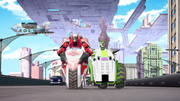

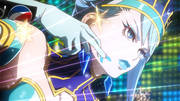

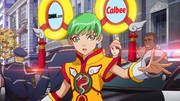

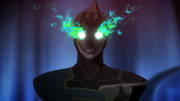
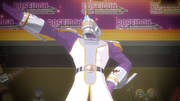
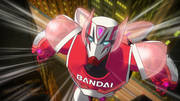
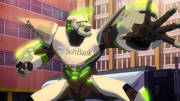












































Your Opinions and Comments
Be the first to post a comment!